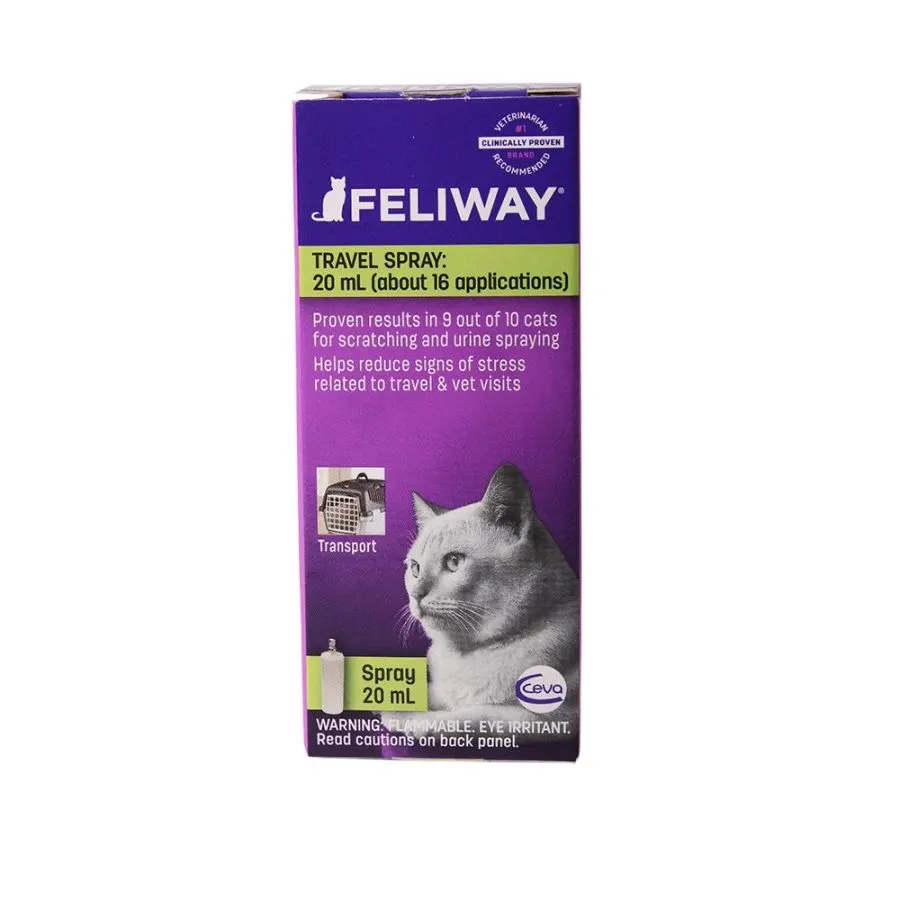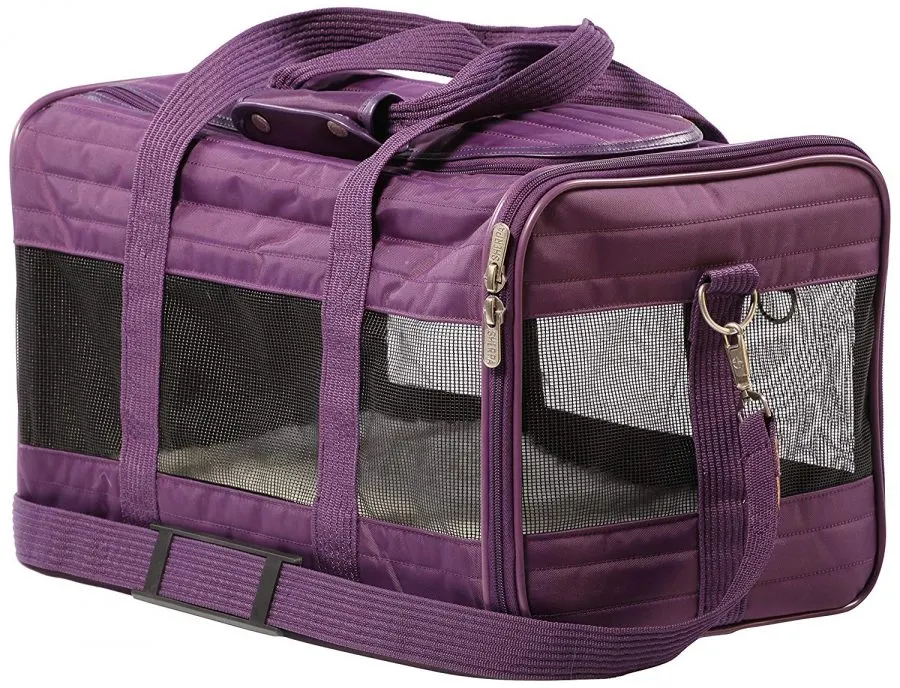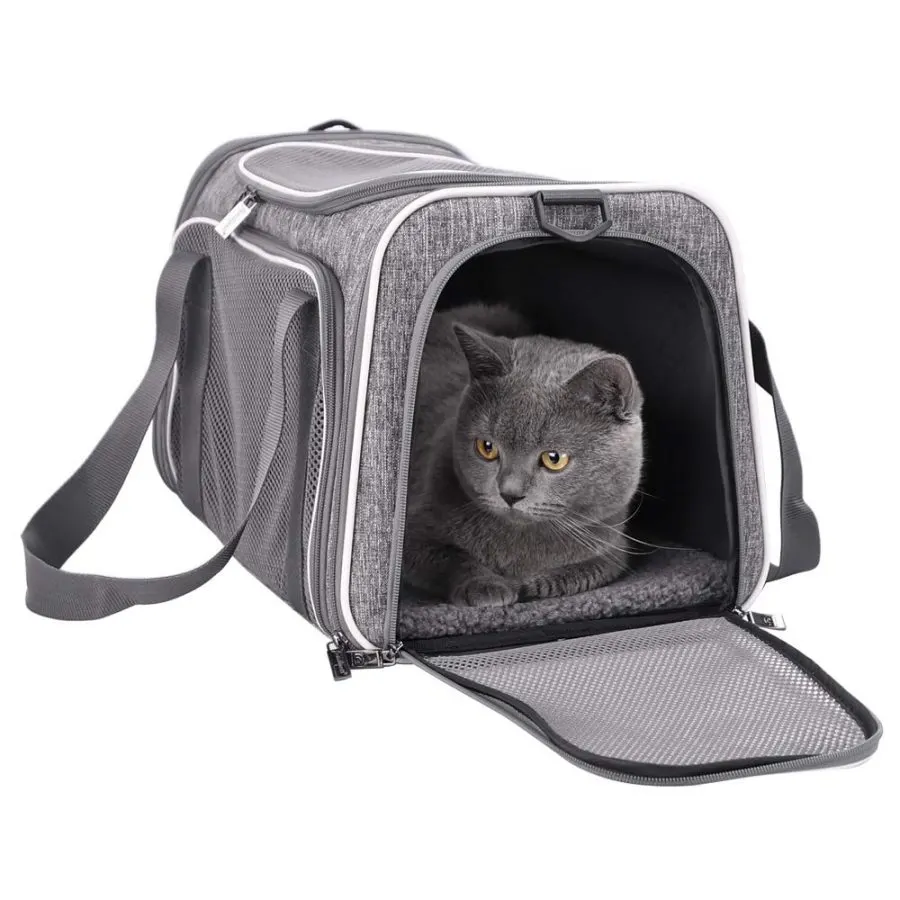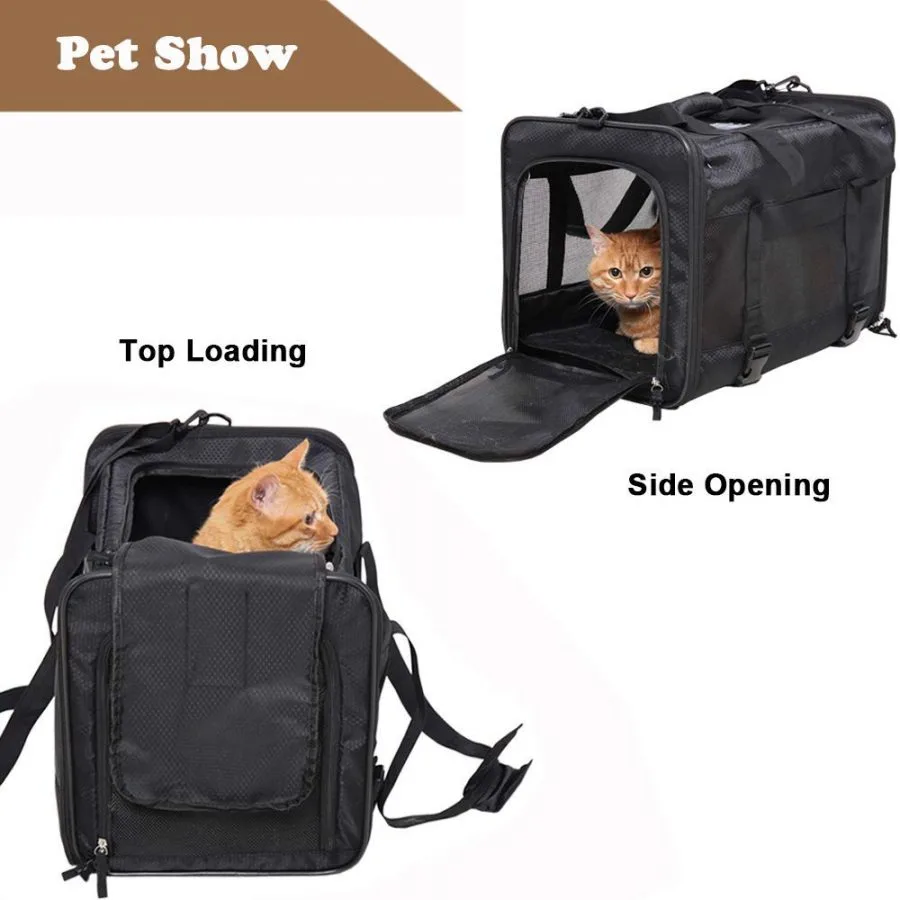What does your cat think of the cat carrier? There’s no question that many–if not most–cats are not fans of the cat carrier. All too often, its appearance means that a stressful event, a trip to the vet, is about to take place! With some pre-planning and a little training, though, you can get your cat into the cat carrier more easily and help your cat accept the carrier!
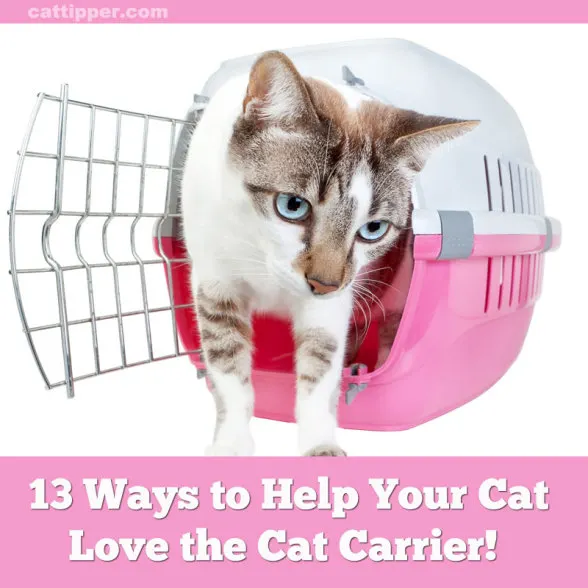
What’s the Best Way to Get Your Cat in a Carrier?
The best way to get your cat into the cat carrier is if he ENJOYS going into the cat carrier! If your cat can go in on his own, your task is much, much easier.
Getting a cat into a carrier can sometimes be challenging, as many cats associate the carrier with stressful situations, like visits to the vet. Here are some steps and tips to make the process smoother:
Familiarize Your Cat with the Carrier:
We’re going to talk more about ways to get your cat familiar with–and enjoying–the carrier below but here’s a sneak peek:
- Leave the carrier out in an area where your cat spends time, allowing them to become familiar with it. Put soft bedding, treats, or toys inside to encourage your cat to enter voluntarily.
- This familiarization can be done days or even weeks before use. The longer the carrier is part of the cat’s environment, the less likely it is to cause anxiety.
Choose a Top-Loading Carrier:
Carriers that have both a front and top opening are ideal. Top-loading options can make it easier to lower your cat into the carrier rather than pushing them through the front.
Prepare the Carrier:
- Line the bottom with a soft blanket or towel. You can also add an article of your clothing to provide a familiar scent.
- Consider using synthetic feline facial pheromone sprays or wipes inside the carrier to make it more comforting.
Getting the Cat Inside:
- Front-Loading Carrier: Open the door and stand it against a wall to prevent it from moving. Gently cradle your cat, holding its front and rear legs, and slide them into the carrier rear-first. This approach often meets less resistance than facing forward.
- Top-Loading Carrier: Hold your cat by the scruff (gently but securely), support their bottom, and lower them into the carrier.
Cover the Carrier:
Once the cat is inside, covering the carrier with a towel or lightweight blanket can help calm the cat by darkening the environment and reducing external stimuli.
Positive Reinforcement:
- Reward your cat with treats and praise both before and after they go into the carrier. This can help create positive associations.
- Consider feeding your cat their meals near, or even inside, the carrier in the days leading up to its use.
Practice:
If every time the carrier appears, it leads to a vet visit, your cat will likely develop a negative association. Try to have some “practice” runs where the cat goes into the carrier but gets let out shortly after, without any stressful events. Over time, this can help desensitize them to the carrier.
Stay Calm:
Cats are perceptive and can pick up on your anxiety or frustration. Remaining calm and speaking in a soothing voice can help reduce their stress.
Remember, every cat is different. What works for one might not work for another, so be patient and adjust your approach based on your cat’s personality and preferences. If you’re having significant difficulty, consider consulting with your veterinarian or a feline behaviorist for additional strategies and tips.
Why Your Cat Needs to Love the Cat Carrier
Even if you don’t worry about evacuation, you’ll find many reasons to help your cat become comfortable with the carrier.
First and foremost, the carrier is your best way to safely transport your cat to the veterinarian’s office. Sadly many cats don’t get the veterinary care they need because many cats are so difficult to take to the vet’s office. By teaching your cat that the carrier is a safe and happy place, you’re not only making the travel easier on your cat (and you!) but you’re also setting him up for success during a lifetime of wellness visits.
Many veterinarian offices require a carrier for the cat’s safety in the office but, even if yours doesn’t, you’ll find that a carrier is a huge safety tool.
Even the calmest cat (including those harnessed) can suddenly bolt in strange situations. The carrier also protects your cat from dogs and other animals in the vet’s office.
Besides the safety of the carrier provides your cat in the office itself, it also offers pet safety in the car. It’s all too easy for an unsecured cat to suddenly run beneath your gas or brake pedal, causing a hazard for everyone in your car and on the road. A cat who is unsecured in the carrier also presents a distraction risk to the driver (have you ever turned around to see if all’s OK in the back seat?!)
And, while you may not have plans to move right now, do you know for sure that you will not be moving in the next decade? Moving with your cat is much, much easier if your cat sees the carrier as a place of safety and security, both in the car and in hotel rooms.
If you’re considering adding a new cat to your family, it’s never too early to introduce your cat to the carrier–and it ensures a safe drive home from the shelter! When we adopted Lucky, we took our carrier to the shelter on the hopes that it would come home with a new occupant…and it did!
Here are our top tips for how to make sure your cat loves the cat carrier–making the task of getting your cat into the cat carrier much easier for you–and much less stressful for your cat!
How I Trained Our Cats to Like the Carrier
I have to admit that, in the past, our cats were NOT crazy about the carrier. It wasn’t just the sight of the carrier than made it them run; the sound of the mere touching of the carrier handle sent them scattering to unknown recesses in our house.
That all changed three years ago when we faced fire danger like we’ve never had before. Because of extreme drought conditions, we knew that there was the very real possibility that we’d need to evacuate the house literally within minutes. We had to do something about our cats’ fear of the carrier.
We soon moved the cat carriers out into the room and left them out around the clock, each with a toy, soft blanket, and, sometimes, a surprise treat or two. Within a few weeks, each of the cats learned to accept their carriers and soon went in on their own!
Keep the Carrier Out
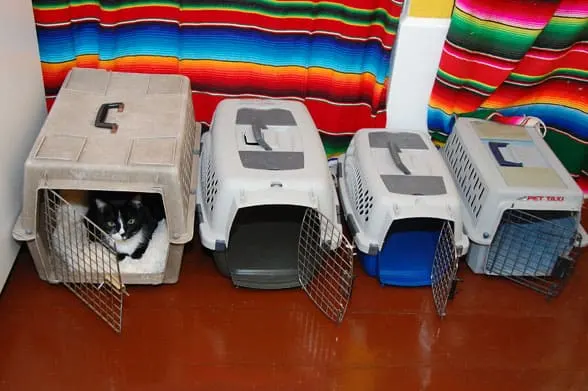
Interestingly enough, just by having those carriers out, all of our cats came to view them like another piece of furniture.
Put a Pad in the Carrier
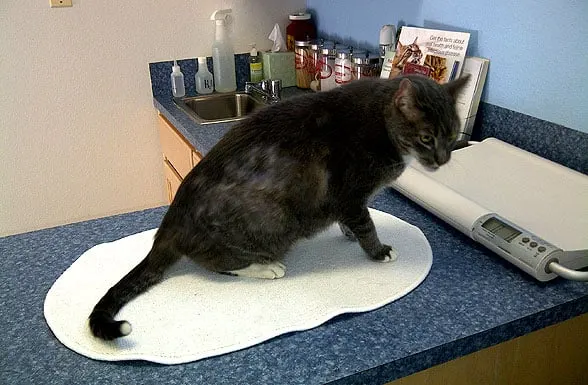
Hard sided carriers aren’t cozy, and they don’t provide any kind of toe hold for your cat. We keep a small bathmat in each carrier; its rubber backing prevents the mat from sliding around the carrier so the cat gets a good grip in the carrier.
Once we’re at the vet, we lift out the bath mat and the cat, putting both on the examination table. The non-slip backing helps the cat feel more secure on the slippery exam table, too!
Feed Your Cat Near the Carrier
Your cat associates food with good times; by placing your carrier near your cat’s food dish, those good associations can begin to extend to the carrier as well.
NOTE: If you see that the carrier’s presence is preventing your cat from eating, move the carrier further away or skip this idea.
Feed Your Cat Inside the Carrier
Once your cat will permit the carrier in the proximity of the food dish, try feeding your cat inside the carrier.
Begin with food right in front of opened carrier door, gradually moving the food further and further back into the carrier with each meal. (Again, if this prevents your cat from eating, skip this idea.)
Try extra-tasty food for this tempting exercise such as wet cat food or dry food with a couple of your cat’s favorite treats mixed in.
Similarly, toss tasty treats back into the carrier, letting your cat discover them inside the carrier. Start with the treats near or around the door then, as your cat becomes more comfortable, begin tossing treats further and further back into the carrier.
Store Toys in the Carrier
Keep some tempting toys inside the carrier to lure your cat inside and to provide good associations with the carrier.
This method has been a great way for us to get our cats to approach and hang out around and IN the cat carrier!
Train Your Cat to Enter the Carrier
Positive reinforcement can go a long way toward training your cat to enter the carrier on command.
Select a word to indicate that you’d like your cat to enter the carrier then train for that behavior, either using a clicker or immediate praise (and adding treats always speeds up the process for us).
Spray the Carrier with Pheromones
Synthetic pheromones that mimic the scent of the pheromones emitted by a nursing mother cat can provide the scent of security for your cat. Spray the carrier; along with sprays, you’ll also find wipes available to wipe down the interior of the carrier.
Practice Using the Carrier
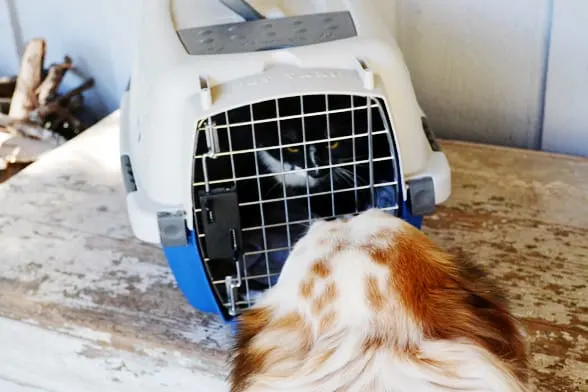
To help both you and your cat become more relaxed, practice using the carrier. Your practice runs may start with just closing the carrier, treating your cat, then releasing him.
Try moving the carrier from room to room and even outdoors and back inside. Both of you will become more comfortable with riding and carrying the carrier.
Clean the Carrier
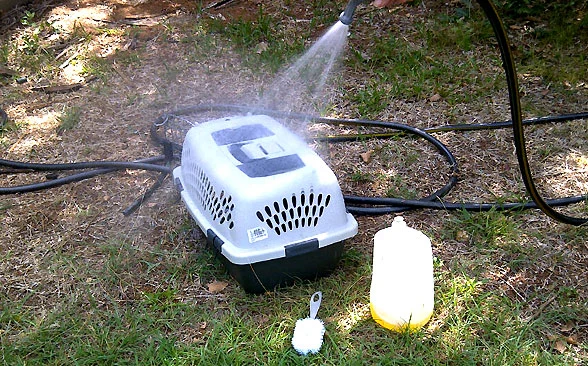
A trip to the veterinarian is a time of stress–and stress means stress hormones.
If you have a hard-sided cat carrier, give it a good scrub to remove that residual scent of stress and the vet’s office.
If you use a soft carrier, remove the pad for washing and spray the carrier with Feliway or at least let it air out in the sunshine to help remove the scent.
Try a Soft Carrier

Many people use a hard-sided carrier because of the ease of use but soft carriers are another option that could be more popular with your cat.
If you ever think you might fly with your cat, train your cat to use a soft carrier that can fit under the seat.
Try a Different Size Carrier
Airline restrictions aside, you’ll want a carrier large enough for your cat to stand up, stretch, and turn around in–but not that much larger.
A carrier that’s too large will make your cat feel a bit lost among all the space. (The exception is if you would like two cats that get along very well to share a single carrier.)
We have several carriers in different sizes because our cats vary from 7 to 14 pounds.
Try a Top Loading Carrier
Your cat may not like the front loading carriers so consider a top loading carrier. As we mentioned above, carriers with a top opening make it easy to lower a cat down into the carrier instead of trying to place the cat in through the front door.
Secure the carrier in the car
Many people lovingly secure their cat inside a cat carrier and carefully place it inside the car—but then fail to secure the cat carrier.
Unless you secure the carrier inside the car, strapping it in using the seat belt, the carrier not only will move around as you drive but it also presents a big risk to your cat and your passengers in case of a sudden stop or accident.
The ride will be much more comfortable for everyone if the carrier is safely buckled and the movement is minimized.
A little extra work can pay off every time you use your cat carrier, whether that’s to travel, move, visit the vet, or evacuate. Helping your cat become acquainted and comfortable with the carrier–rather than seeing it as a frightening object–will reduce the stress for both you and your cat regardless of your travel plans!
More Tips
How to Get a Cat to Use a Scratching Post
Can I Add Water to My Cat’s Dry Food?
How to Remove Cat Pee from Carpet, Laminate Flooring and More
- 🎉 GIVEAWAY: Lord of the Pets Portrait of Your Cat! - November 26, 2024
- Review: Lord of the Pets Cat Portraits! - November 26, 2024
- Cat Adoption: FAQ You Might Have - June 28, 2024

